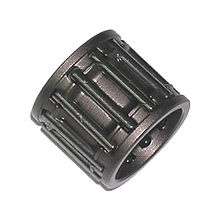Needle roller bearing

A needle roller bearing is a bearing which uses small cylindrical rollers.The difference between a needle roller bearing and roller bearing is the ratio of diameter and length of their rollers, when the ratio of the diameter and the length of roller of a roller bearing is between the interval of 0.1 to 0.4, that roller bearing is called a needle roller bearing. They are used to reduce the friction of a rotating surface.
Needle bearings have a large surface area that is in contact with the bearing outer surfaces compared to ball bearings. Additionally there is less added clearance (difference between the diameter of the shaft and the diameter of the bearing) so they are much more compact. The typical structure consists of a needle cage which orients and contains the needle rollers, the needle rollers themselves, and an outer race (sometimes the housing itself).
Radial needle bearings are cylindrical and use rollers parallel to the axis of the shaft. Thrust needle bearings are flat and use a radial pattern of needles.
Full complement bearings have solid inner and outer rings and rib-guided cylindrical rollers. Since these bearings have the largest possible number of rolling elements, they have extremely high radial load carrying capacity and are suitable for particularly compact designs. [1]
Needle bearings are heavily used in automobile components such as rocker arm pivots, pumps, compressors, and transmissions. The drive shaft of a rear-wheel drive vehicle typically has at least eight needle bearings (four in each U joint) and often more if it is particularly long, or operates on steep slopes.
Additional clarification of needle roller: According to "Marks' Standard Handbook for Mechanical Engineers", a needle bearing is a roller bearing with rollers whose length are at least four times their diameter.
See also
References
- ↑ Timken bearings website